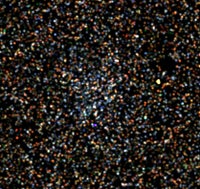While mapping streams of stars coursing through the Milky Way’s halo, astronomers at Cambridge University in England discovered two new, faint satellite galaxies orbiting our own.
Vasily Belokurov, Daniel Zucker, and their colleagues used Sloan Digital Sky Survey (SDSS) data spanning nearly one-quarter of the sky to create the clearest-ever view of stars streaming near the Milky Way’s north pole. To see the distant structures, the astronomers eliminated red, nearby stars. So many trails crisscrossed the resulting view that the team has dubbed the area the “Field of Streams.”
“The two new satellites do not appear to be associated with any of the prominent stellar streams in the Field of Streams,” Zucker tells Astronomy. “But we can’t rule out the possibility they might have extremely faint stellar streams of their own that lie below our current detection limits.” The team has submitted papers about the new galaxies and the Field of Streams to The Astrophysical Journal.
Stellar rivers form as the Milky Way’s tides slowly shred smaller satellite galaxies and globular star clusters (see “Stellar Archaeology,” May 2005). The star streams arise because stellar debris drifts out along the ruptured systems’ orbits.
While studying the Field of Streams, Zucker explains he noticed an obvious overdensity of stars in Canes Venatici. The dwarf galaxy is about 640,000 light-years away, which makes it a contender for the most distant Milky Way companion.
Zucker e-mailed his colleague Belokurov with the news. A few hours later, Belokurov e-mailed Zucker with the discovery of a new, even fainter dwarf galaxy.
The find, which Belokurov nicknames “Boo,” lies 196,000 light-years away in Boötes. Shining with the luminosity of 100,000 Suns, Boo is the faintest galaxy yet discovered. “Something really bashed Boo about,” says Belokurov. The dwarf galaxy’s shape appears distorted, as if it’s responding to the Milky Way’s disrupting gravitational influence.
“We believe they are galaxies based on their size,” Zucker explains. The astronomers measured the objects’ sizes in terms of their “half-light radii,” that is, the radial distance at which their luminosities fall by half. The Boötes dwarf is about 720 light-years across; the Canes Venatici dwarf is about 1,800 light-years wide.
“Boötes, the smaller of the two, is 10 times the size of a large globular cluster, and Canes Venatici is more than 2 times larger than Boötes,” Zucker notes. Zucker says his team doesn’t know much about the objects’ orbits yet because the astronomers lack velocity information for the member stars. “We’re working to get these data with follow-up observations.”
The most prominent feature of the Field of Streams is the enormous arching trail created by the Sagittarius dwarf galaxy. The Sagittarius dwarf, which is being ripped asunder as it orbits the Milky Way, was discovered more than a decade ago. Since then, researchers have mapped its starry stream across the sky.
But the SDSS data revealed a new detail.
“The stream appears forked,” says Belokurov. “We are seeing different
wraps superimposed on the sky, as the stream goes around the galaxy two or
three times.”
Team member Mike Fellhauer of Cambridge University says the Sagittarius stream tells astronomers something about how the Milky Way’s dark matter is distributed. “The leading theories of dark matter predict that the galaxy’s halo should be flattened, like a rugby football. But our simulations only match the forked Sagittarius stream if the inner halo is round, like a soccer ball.”
| Milky Way head count |
| According to Daniel Zucker, astronomers now accept 14 mini-galaxies as Milky Way satellites. This tally includes the Large and Small Magellanic Clouds (classed as dwarf irregular galaxies), and 10 dwarf spheroidal galaxies: Draco, Ursa Minor, Sextans, Sculptor, Leo I , Leo II, Fornax, Ursa Major, Sagittarius, and Carina. The two new satellites, Canes Venatici and Boötes, are also classed as dwarf spheroidals.
Not included in this count are two possible disrupting satellites, Canis Major and the Virgo Overdensity, whose identifications remain somewhat controversial. The Virgo Overdensity was also found using SDSS data. — F. R. |
James Bullock, a theorist at the University of California, Irvine, not affiliated with the study, agrees there are implications for dark matter. “The fact that we can see a ‘Field of Streams’ like this suggests that dark-matter particles are very cold, or slow moving. If the dark matter was made up of warm, fast-moving particles, we wouldn’t expect these thin streams to hang around long enough for us to find them,” he explains.
Another prominent trail is the Monoceros stream, discovered previously by team members Heidi Jo Newberg of Rensselaer Polytechnic Institute, New York, and Brian Yanny of the Fermi National Accelerator Laboratory in Illinois. The Monoceros stream is all that’s left of a dwarf satellite the Milky Way long ago absorbed.
Analysis of the SDSS data also revealed a new stream that spans over 70° of sky. Its source galaxy remains unknown. “We’re looking for it right now,” says team member Wyn Evans of Cambridge University.
Astronomers have known about merging events for years, but the SDSS Field of Streams provides them with a dramatic example of ongoing activity in our own galaxy. “This is happening all over the universe, as big galaxies grow by tearing up smaller ones into streams,” says Yanny.










